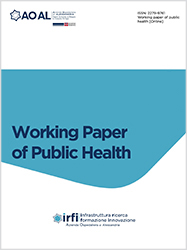Economic analysis and time monitoring of pediatric venipuncture procedures; audio-visual distraction and Buzzy® device versus standard care: protocol of an interventional randomized controlled trial

Accepted: 22 March 2023
All claims expressed in this article are solely those of the authors and do not necessarily represent those of their affiliated organizations, or those of the publisher, the editors and the reviewers. Any product that may be evaluated in this article or claim that may be made by its manufacturer is not guaranteed or endorsed by the publisher.
Background: reducing anxiety and pain during an invasive procedure like venipuncture is crucial for preventing the onset of stress and making the nurse’s procedures faster and smoother. Distraction techniques appear to be a viable solution. The aim of this study is to compare the effectiveness of two different distraction methods in terms of cost-effectiveness and time to perform venipuncture in a hospital setting. Materials and Methods: a randomized, controlled, interventional-blinded 3-arm parallel-group study with inpatients aged 3 to 18 years old, awake and conscious, at the first venipuncture attempt and only after children and parents signed informed consent. The pain rating scales Wong-Baker FACES, Numerical Rating Scale, and Children’s Fear Scale will be used. Conclusions: pediatric pain is a challenge for medical professionals as well as a health need that must be addressed rapidly. It is crucial to assess and apply the most effective methods for adequate analgesia in shorter periods, while also reducing healthcare costs.
Chen Y, Min C, Wang Q, et al. Procedural Pain in Hospitalized Children in a Chinese Children’s Hospital. Pain Manag Nurs Off J Am Soc Pain Manag Nurses. 2021;22:414–22. DOI: https://doi.org/10.1016/j.pmn.2020.11.009
Boussicault G, Ollivier M, Allard L, Ringuier B. Accessi venosi nel neonato, nel lattante e nel bambino. EMC - Anest-Rianim. 2018;23:1–24. DOI: https://doi.org/10.1016/S1283-0771(17)87835-X
Inan G, Inal S. The Impact of 3 Different Distraction Techniques on the Pain and Anxiety Levels of Children During Venipuncture: A Clinical Trial. Clin J Pain. 2019;35:140–7. DOI: https://doi.org/10.1097/AJP.0000000000000666
Schinkel MG, Boerner KE, Chambers CT, McMurtry CM. Adult judgments of children’s pain and fear during venipuncture: The impact of adult and child sex. Can J Pain. 2018;2:292–301. DOI: https://doi.org/10.1080/24740527.2018.1537672
Arıkan A, Esenay FI. Active and Passive Distraction Interventions in a Pediatric Emergency Department to Reduce the Pain and Anxiety During Venous Blood Sampling: A Randomized Clinical Trial. J Emerg Nurs. 2020;46:779–90. DOI: https://doi.org/10.1016/j.jen.2020.05.004
Mahoney L, Ayers S, Seddon P. The Association Between Parent’s and Healthcare Professional’s Behavior and Children’s Coping and Distress During Venipuncture. J Pediatr Psychol. 2010;35:985–95. DOI: https://doi.org/10.1093/jpepsy/jsq009
Taddio A, Appleton M, Bortolussi R, et al. Reducing the pain of childhood vaccination: an evidence-based clinical practice guideline (summary). Can Med Assoc J. 2010;182:1989–95. DOI: https://doi.org/10.1503/cmaj.092048
McCarthy AM, Kleiber C. A Conceptual Model of Factors Influencing Children’s Responses to a Painful Procedure When Parents are Distraction Coaches. J Pediatr Nurs. 2006;21:88–98. DOI: https://doi.org/10.1016/j.pedn.2005.06.007
Pedro H, Barros L, Moleiro C. Brief Report: Parents and Nurses’ Behaviors Associated with Child Distress during Routine Immunization in a Portuguese Population. J Pediatr Psychol. 2010;35:602–10. DOI: https://doi.org/10.1093/jpepsy/jsp062
American Pain Society Task Force. The assessment and management of acute pain in infants, children, and adolescents. Pediatr-Springf-. 2001;108:793-7. DOI: https://doi.org/10.1542/peds.108.3.793
Paediatric Association of Anaesthetists of Great Britain and Ireland. Good Practice in Postoperative and Procedural Pain Management, 2nd Edition. Pediatr Anesth. 2012;22:1–79. DOI: https://doi.org/10.1111/j.1460-9592.2012.03838.x
Ali S, Manaloor R, Ma K, et al. A randomized trial of robot-based distraction to reduce children’s distress and pain during intravenous insertion in the emergency department. Can J Emerg Med. 2021;23:85–93. DOI: https://doi.org/10.1007/s43678-020-00023-5
Ryu JH, Han SH, Hwang SM, et al. Effects of Virtual Reality Education on Procedural Pain and Anxiety During Venipuncture in Children: A Randomized Clinical Trial. Front Med. 2022;9:849541. DOI: https://doi.org/10.3389/fmed.2022.849541
Wente SJK. Nonpharmacologic Pediatric Pain Management in Emergency Departments: A Systematic Review of the Literature. J Emerg Nurs. 2013;39:140–50. DOI: https://doi.org/10.1016/j.jen.2012.09.011
Canares TL, Parrish C, Santos C, et al. Resource Use During Pediatric Venipuncture With Virtual Reality: Secondary Analysis of a Randomized Controlled Pilot Trial. Hosp Pediatr. 2021;11:775–8. DOI: https://doi.org/10.1542/hpeds.2020-003822
Birnie KA, Noel M, Chambers CT, et al. Psychological interventions for needle-related procedural pain and distress in children and adolescents. Cochrane Pain, Palliative and Supportive Care Group, editor. Cochrane Database Syst Rev. 2018;10:CD005179. DOI: https://doi.org/10.1002/14651858.CD005179.pub4
Krauss BS, Calligaris L, Green SM, Barbi E. Current concepts in management of pain in children in the emergency department. The Lancet. 2016;387:83–92.
Krauss BS, Calligaris L, Green SM, Barbi E. Current concepts in management of pain in children in the emergency department. The Lancet. 2016;387:83–92. DOI: https://doi.org/10.1016/S0140-6736(14)61686-X
Arane K, Behboudi A, Goldman RD. Virtual reality for pain and anxiety management in children. Can Fam Physician. 2017;63:932–4.
Pourmand A, Davis S, Marchak A, et al. Virtual Reality as a Clinical Tool for Pain Management. Curr Pain Headache Rep. 2018;22:53. DOI: https://doi.org/10.1007/s11916-018-0708-2
Gerçeker GO, Ayar D, Özdemir EZ, et al. Effects of virtual reality on pain, fear and anxiety during blood draw in children aged 5–12 years old: A randomised controlled study. J Clin Nurs. 2020;29:1151–61. DOI: https://doi.org/10.1111/jocn.15173
Gupta A, Scott K, Dukewich M. Innovative Technology Using Virtual Reality in the Treatment of Pain: Does It Reduce Pain via Distraction, or Is There More to It? Pain Med. 2018;19:151–9. DOI: https://doi.org/10.1093/pm/pnx109
Gold JI, Mahrer NE. Is Virtual Reality Ready for Prime Time in the Medical Space? A Randomized Control Trial of Pediatric Virtual Reality for Acute Procedural Pain Management. J Pediatr Psychol. 2018;43:266–75. DOI: https://doi.org/10.1093/jpepsy/jsx129
McNair C, Campbell-Yeo M, Johnston C, Taddio A. Nonpharmacologic Management of Pain During Common Needle Puncture Procedures in Infants. Clin Perinatol. 2019;46:709–30. DOI: https://doi.org/10.1016/j.clp.2019.08.006
Lescop K, Joret I, Delbos P, et al. The effectiveness of the BuzzyⓇ device to reduce or prevent pain in children undergoing needle-related procedures: The results from a prospective, open-label, randomised, non-inferiority study. Int J Nurs Stud. 2021;113:103803. DOI: https://doi.org/10.1016/j.ijnurstu.2020.103803
Ballard A, Khadra C, Adler S, et al. Efficacy of the Buzzy® device for pain management of children during needle-related procedures: a systematic review protocol. Syst Rev. 2018;7:78. DOI: https://doi.org/10.1186/s13643-018-0738-1
Su HC, Hsieh CW, Lai NM, et al. Using Vibrating and Cold Device for Pain Relieves in Children: A Systematic Review and Meta-analysis of Randomized Controlled Trials. J Pediatr Nurs. 2021;61:23–33. DOI: https://doi.org/10.1016/j.pedn.2021.02.027
Wong DL, Baker CM. Pain in children: comparison of assessment scales. Pediatr Nurse. 1988;14:9–17.
Downie WW, Leatham PA, Rhind VM, et al. Studies with pain rating scales. Ann Rheum Dis. 1978;37:378–81. DOI: https://doi.org/10.1136/ard.37.4.378
McMurtry CM, Noel M, Chambers CT, McGrath PJ. Children’s fear during procedural pain: Preliminary investigation of the Children’s Fear Scale. Health Psychol. 2011;30:780–8. DOI: https://doi.org/10.1037/a0024817
Hussein HA. Effect of active and passive distraction on decreasing pain associated with painful medical procedures among school aged children. World J Nurs Sci 12 13-23. 2015;1:13–23.
Lessi E. Il dolore da venipuntura nel bambino: il beneficio della distrazione con audiovisivi. Edizioni Accademiche Italiane. 2016. 108 pp.
Viggiano MP, Giganti F, Rossi A, et al. Impact of Psychological Interventions on Reducing Anxiety, Fear and the Need for Sedation in Children Undergoing Magnetic Resonance Imaging. Pediatr Rep. 2015;7:5682. DOI: https://doi.org/10.4081/pr.2015.5682
Rezai MS, Goudarzian AH, Jafari-Koulaee A, Bagheri-Nesami M. The Effect of Distraction Techniques on the Pain of Venipuncture in Children: A Systematic Review. J Pediatr Rev. 2017;5:26-37. DOI: https://doi.org/10.17795/jpr-9459
Bagnasco A, Pezzi E, Rosa F, et al. Distraction Techniques in Children during Venipuncture: An Italian Experience. J Prev Med Hyg. 2012;53:44–8.
Copyright (c) 2023 Roberta Di Matteo, Michela Gentile, Elena Grassi, Denise Gatti, Tatiana Bolgeo, Antonio Maconi

This work is licensed under a Creative Commons Attribution-NonCommercial 4.0 International License.
PAGEPress has chosen to apply the Creative Commons Attribution NonCommercial 4.0 International License (CC BY-NC 4.0) to all manuscripts to be published.

 https://doi.org/10.4081/wpph.2023.9684
https://doi.org/10.4081/wpph.2023.9684




